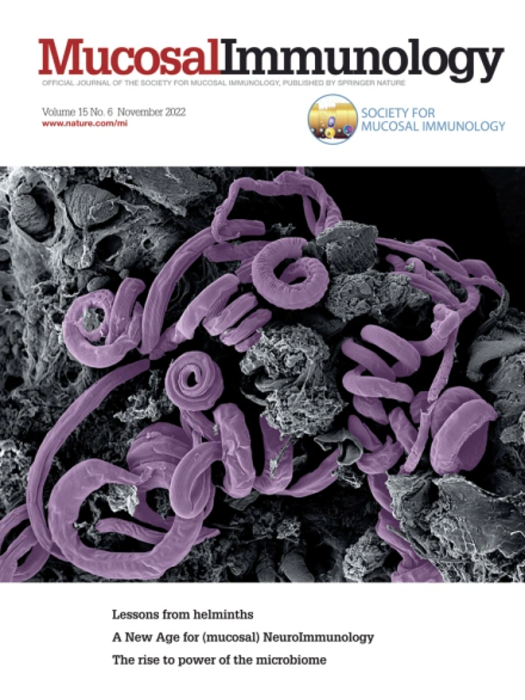IL-33与病毒性下呼吸道疾病患者肺泡功能障碍相关
IF 7.6
2区 医学
Q1 IMMUNOLOGY
引用次数: 0
摘要
白细胞介素(IL)-33在组织损伤后释放,通过减少IL-33 (IL-33red)/血清刺激-2 (ST2)和氧化IL-33 (IL-33ox)/晚期糖基化终产物受体(RAGE)/表皮生长因子受体(EGFR)途径引起气道炎症和重塑。本研究旨在确定IL-33与病毒性下呼吸道疾病(LRTD)临床结局和病理机制的关联。开发了超灵敏的免疫测定方法来测量COVID-19住院患者样本中的IL-33red、IL-33ox和IL-33/sST2复合物。使用免疫组织化学和多组学来表征肺样本。气道中IL-33和循环中IL-33/sST2复合物升高与不良临床结果(死亡、需要重症监护或机械通气)相关。IL-33定位于气道上皮和内皮屏障,而IL1RL1表达于专门用于气体交换的肺泡内皮细胞。IL-33在内皮细胞培养中增加中性粒细胞炎症、免疫细胞浸润、干扰素信号和凝血介质的表达。内皮细胞IL-33特征与病毒LRTD相关的特征密切相关。呼吸道病毒感染后IL-33释放增加与不良临床结果相关,并可能导致肺泡功能障碍。虽然这并没有显示出与疾病的因果关系,但这些结果为评估IL-33在病毒性LRTD中的病理作用提供了依据。本文章由计算机程序翻译,如有差异,请以英文原文为准。

IL-33 is associated with alveolar dysfunction in patients with viral lower respiratory tract disease
Interleukin (IL)-33 is released following tissue damage, causing airway inflammation and remodelling via reduced IL-33 (IL-33red)/serum stimulation-2 (ST2) and oxidised IL-33 (IL-33ox)/receptor for advanced glycation end products (RAGE)/epidermal growth factor receptor (EGFR) pathways. This study aimed to identify associations of IL-33 with clinical outcomes and pathological mechanisms during viral lower respiratory tract disease (LRTD). Ultra-sensitive immunoassays were developed to measure IL-33red, IL-33ox and IL-33/sST2 complexes in samples from patients hospitalised with COVID-19. Immunohistochemistry and multiomics were used to characterise lung samples. Elevated IL-33 in the airway and IL-33/sST2 complex in the circulation correlated with poor clinical outcomes (death, need for intensive care or mechanical ventilation). IL-33 was localised to airway epithelial and endothelial barriers, whereas IL1RL1 was expressed on aerocytes, alveolar endothelial cells specialised for gaseous exchange. IL-33 increased expression of mediators of neutrophilic inflammation, immune cell infiltration, interferon signalling and coagulation in endothelial cell cultures. Endothelial IL-33 signatures were strongly related with signatures associated with viral LRTD. Increased IL-33 release following respiratory viral infections is associated with poor clinical outcomes and might contribute to alveolar dysfunction. Although this does not show a causal relationship with disease, these results provide a rationale to evaluate pathological roles for IL-33 in viral LRTD.
求助全文
通过发布文献求助,成功后即可免费获取论文全文。
去求助
来源期刊

Mucosal Immunology
医学-免疫学
CiteScore
16.60
自引率
3.80%
发文量
100
审稿时长
12 days
期刊介绍:
Mucosal Immunology, the official publication of the Society of Mucosal Immunology (SMI), serves as a forum for both basic and clinical scientists to discuss immunity and inflammation involving mucosal tissues. It covers gastrointestinal, pulmonary, nasopharyngeal, oral, ocular, and genitourinary immunology through original research articles, scholarly reviews, commentaries, editorials, and letters. The journal gives equal consideration to basic, translational, and clinical studies and also serves as a primary communication channel for the SMI governing board and its members, featuring society news, meeting announcements, policy discussions, and job/training opportunities advertisements.
 求助内容:
求助内容: 应助结果提醒方式:
应助结果提醒方式:


